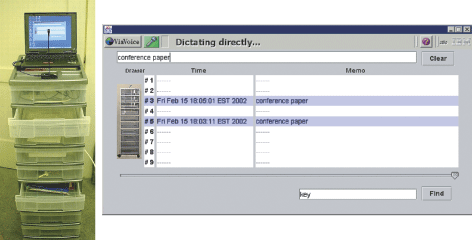
Fig.1. Timastamp Drawers
Digital Decor is furniture, appliances, and other small objects commonly found in homes and offices that have been augmented with computational power to extend usefulness.
As such, Digital Decor is a physical manifestation of the ubiquitous, pervasive, and invisible computer in which the familiar, everyday object is imbued with additional capabilities through a single, simple application.
It is not unusual to find yourself asking: "Where is the document I received at that meeting?"
Although it may be difficult to remember exactly where we have stored a particular document, you may easily remember that the document was distributed at a particular meeting. If the document could be retrieved based on the knowledge that it was distributed at a particular meeting, then retrieving the item would be made easier.
Further, the time of particular events (like the aforementioned meeting) can be determined from the daily schedule found in a person's public calendar. With this information, the previous question can be converted to:
"Where is the document I received Tuesday afternoon?"
Storage furniture like shelves and drawers that record timestamps of human access to its compartments can then be used direct the user where to look.

Fig.1. Timastamp Drawers
Figure 1 shows the Timestamp Drawers, one of the Digital Decor prototypes. This cabinet is 107cm high x 32cm wide x 40cm deep and has 10 drawers, each with an open/close sensor created from a reed switch and magnet combination. Open/close events of drawers are logged and time-stamped by the computer located on top of the drawers.
These drawer events are logged and displayed as shown on the right in Fig. 1, where each line indicates a drawer with its timestamp. Additionally a user can add text annotations to the log of opened drawers, using either the keyboard or voice recognition (IBM ViaVoice).
A user can browse the Timestamp Drawer's log to find the drawer which likely has the desired item either by moving the time slider looking for an event that coincides with the meeting in question, or by searching for keywords in the annotations.
This cabinet has a single, deep drawer equipped with a camera, a depth-sensor and a computer. When a user places an object in the drawer and closes it, a photograph is automatically taken, and the height of the contents is measured by a laser beam. A user can browse pictures of strata in the drawer's contents, with timestamps and height information.
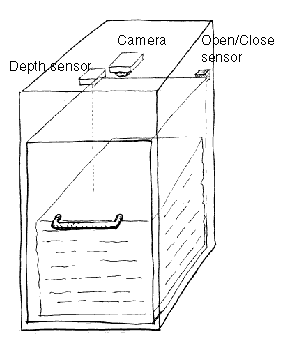
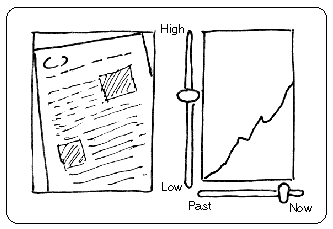
Fig. 2 Strata Drawer idea.
This drawers can be used to find stacked documents in a drawer, and to find home articles such as clothes.
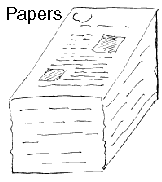
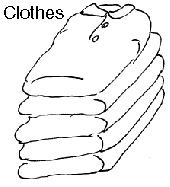
Fig. 3 Stacked objects in the drawer
Made from a commercially available chest, the Strata Drawer measures 64cm high x 49cm wide x 39cm deep. We have equipped the cabinet with a reed switch, halogen lamps, a digital camera (Olympus D-360L), a laser LED, and electronic circuits. These devices are connected to the computer (1GHz Pentium III with Linux OS), which is running two software components; a picture-taking program and a WWW server.
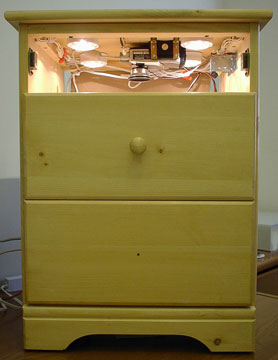
Fig. 4 The Strata Drawer has a digital camera and a laser diode
When a user closes the drawer, the program in the computer detects the drawer-close event through the reed switch, turns on the lamps, takes a picture and transfers the picture to the computer.
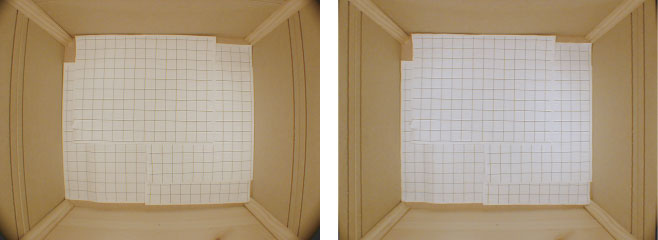
Fig. 5 Compensated image (right)
The barrel distortion created by wide-angle converter lens of 0.6X is compensated for by code in the picture-taking program. Other code in the picture-taking program adjusts the white balance of the picture (Fig. 5).
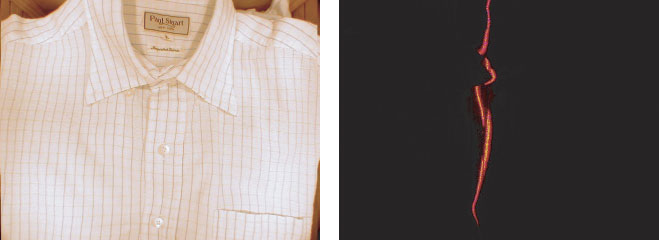
Fig. 6 After taking a picture in the drawer (left), the picture-taking program turns on the laser and takes a second picture of the drawer contents illuminated by the laser line to determine the height of the drawer contents.
A laser LED is located in the upper right-hand corner of the Strata Drawer and projects light diagonally to the lower left-hand corner of the drawer below. A cylindrical lens is placed in front of the laser causing it to project a line of laser light across the contents of the drawer. Since the laser beam shines diagonally across the contents of the drawer, the height of the contents is measured as the distance from the edge of the drawer to the line drawn by the laser. The further the line of laser light is from the left-hand edge of the drawer, the higher the contents in that drawer. (Fig.6)
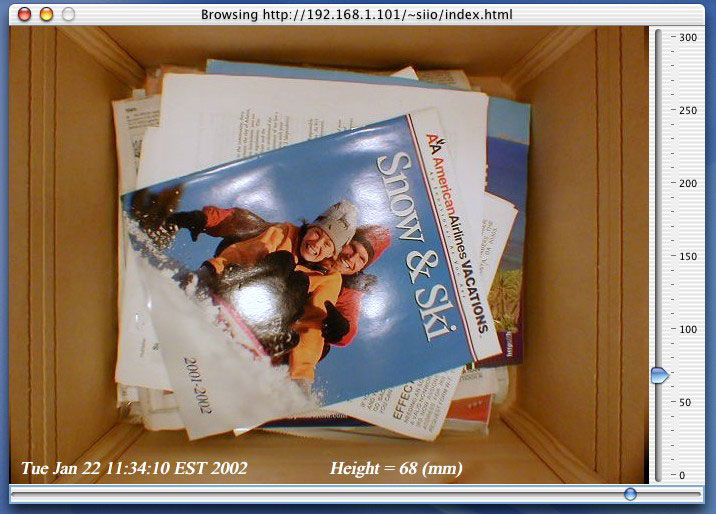
Fig.7 The Strata Drawer browser has time and depth sliders to browse through the stack of objects that are in the drawer.
The picture taken by the camera is placed on the WWW server with a timestamp along with the measured depth information. A dedicated browser for the page has been written in Java and shown in Fig. 7. This browser provides the user with time and depth sliders to navigate the captured images. Since these images are on the WWW, browsing can be done from any computer with access to the Internet.
This is the box version of the Strata Drawers. The cover of the chest has a camera and open/close sensor. It takes photos inside the chest when the cover is closed. These snapshots will be browsed on a computer display by time sequence to support finding objects.

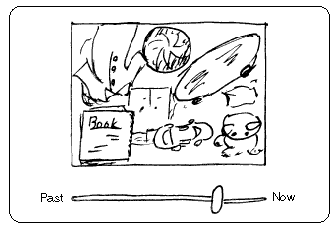
This is the cupboard version of above prototypes. The door of the cupboard has a camera and open/close sensor. It takes photos inside the cupboard when the door is going to be closed. These snapshots will be browsed on a computer display by time sequence to support finding objects.
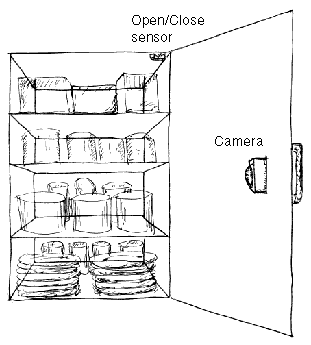
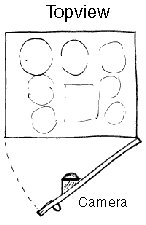
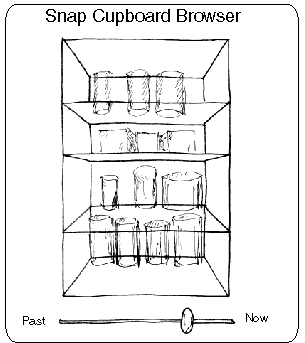
Grandparents want to share a part of their living space with their grandchildren who live far away.
Peek-A-Drawer provides virtual shared drawers across distant locations. When a user puts something in the upper drawer and closes it, a photograph is taken automatically, and the image appears in the lower drawer at a distant place. Past pictures can be accessed by pressing buttons on the lower drawer.
The operation is so simple -using a drawer- that even children can communicate with their grandparents. As the camera only takes objects inside the drawer, privacy is assured.

In the upper drawer, an area which is 30.8cm below the camera. As objects are close to the lens, a wide-angle converter lens (0.5X) is used to allow the capture of the entire contents of the drawer.
In the lower drawer of each chest we have installed a computer (900MHz Celeron with Linux OS), a 15-inch LCD and buttons for navigation. The pictures taken by the camera are shared over an Internet connection between the computers in the two chests. The LCD in the lower drawer of one chest displays images of the contents of the upper drawer in the distant chest. Placing the LCD face up in the lower drawer provides the illusion that the user is looking into the distant drawer.
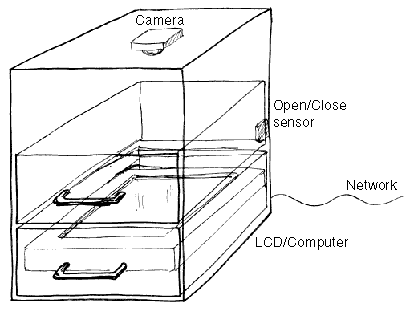
Two set of the drawers will be installed in distant places, for example, separate co-workers, separate families. The snapshot of the local drawer is transmitted to the remote drawer and displayed on the LCD. By this mechanism, the users in distant places can share image of their drawers.
The drawer with LCD at the receiver side may be designed to come out automatically when the drawer at the sender side is pushed in. This mechanism indicates naturally that the sender has transmitted a photo.
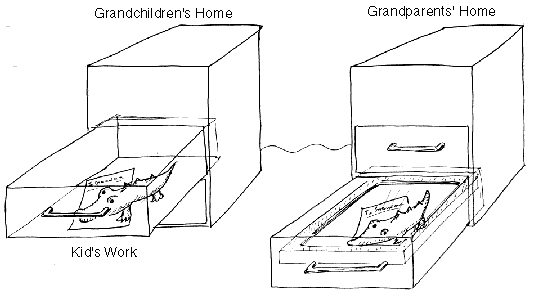
By sharing drawers, co-workers can communicate by sharing on going project documents, planning travel tickets, references,
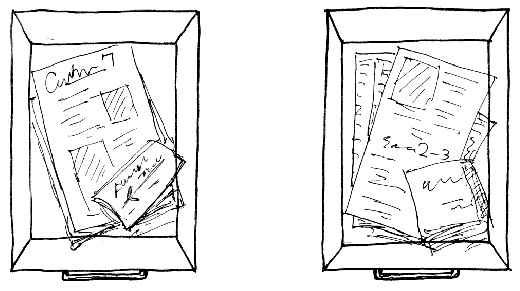
and kids can send snapshots of their handworks at schools/kindergarten to their grandparents.

(Home Requirements: They want to communicate separate old parents with bother-less and easy way even infants can. They, however, don't want to give cameras to their kids because of privacy issues if the camera transmits photos automatically to outside their home. The Shared Drawers limits the shooting objects inside the drawer to solve the privacy issue. )
![]() StrataDrawer,
StrataDrawer, ![]() SnapChest,
SnapChest,
![]() SnapCupboard,
SnapCupboard, ![]() Peek-A-Drawer ,
Peek-A-Drawer ,
![]() Peek-A-Drawer Applications
Peek-A-Drawer Applications
to Siio's home page (English)
椎尾のホームページへ(Japanese)